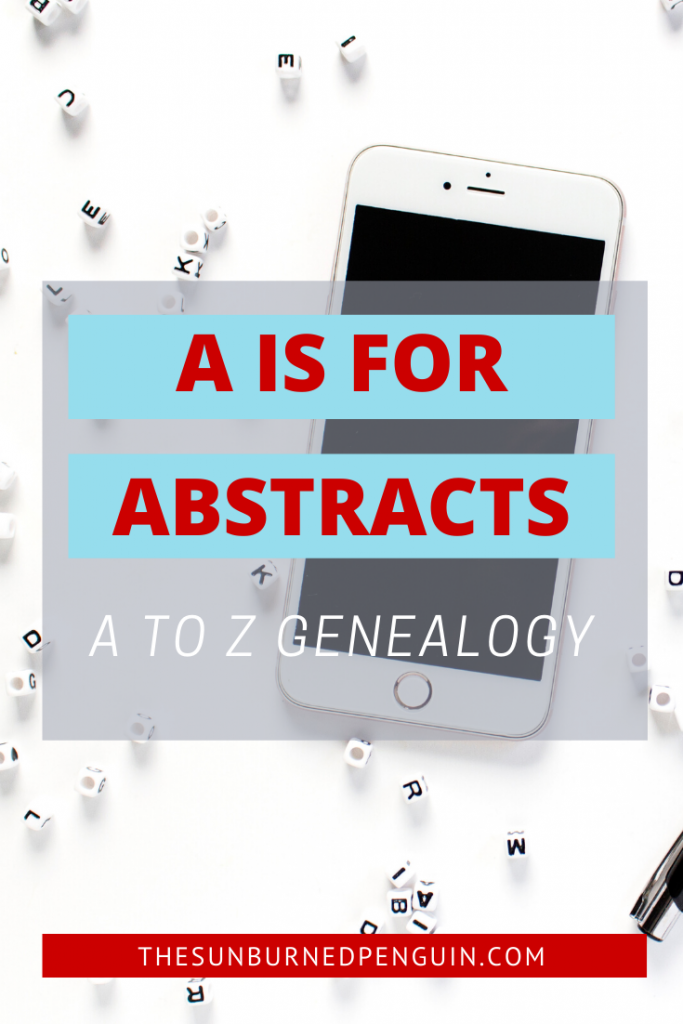This is the first post in a year-long “A to Z Genealogy” series. Follow the entire series here.
I have a love/hate relationship with Abstracts. It’s leaning a bit towards the “hate” side at the current moment, but that’s likely because I’m still learning how best to construct them.

What is an Abstract? “An abstract removes unnecessary words or phrases from a transcription so that only the essential material remains”.1 The “Genealogy Standards” manual states that “Abstracts omit redundant, repetitive and formulaic wording . . . and judiciously smooth out the remaining text.”2
In other words, it’s an extract of the important info from a record, like a will or a deed. Abstracts can be very helpful in determining if further research needs to be done, or used as a tool for study and comparison.
They’re not easy to create.
First, you transcribe the entire document, following rules and standards for accuracy.3 Then, you extract the information that makes the document unique. Conversely, you could also strike out the formulaic words and phrases, and then smooth out the remaining text. Always keep in mind, however, to ensure that the author’s intent is still clear in the abstract.
For example, I have a copy of a will from my 3x great grandfather. In it, he clearly states the reasons he’s practically disinheriting several of his sons. I’d want to make sure that information is in the abstract. But I’d be fine to leave out the boilerplate text, such as “do make and publish this my Last Will and Testament, hereby Revoking all former Wills heretofore made”.4
To see examples of documents transcribed and abstracted, or to try to do the process yourself, check out the Board for Certification of Genealogists “Skills” section on their website.
If you’d like to learn more about the art of abstracting, Chapter 16 in “Professional Genealogy*” (2001, ed. Elizabeth Shown Mills) by Mary McCampbell Bell comes highly recommended. For help with translating handwriting, Kip Sperry’s “Reading Early American Handwriting*” is a key resource. And since transcribing the document is usually the first step, you may appreciate the in-depth webinar by the current BCG president, LaBrenda Garrett-Nelson “Transcribing Documents: There is More Than Meets the Eye!“
Enjoy!
~R
- Sara A. Scribner, “The Devil is in the Details: Transcribing and Abstracting Documents”, Intermediate Genealogy, 2019 syllabus, Salt Lake Institute of Genealogy (Virtual : SLIG Fall 2019), p. 135.
- Board for Certification of Genealogists, Genealogy Standards, second edition. Nashville, Tenn.: Turner Publishing. See Standard 30, p. 19.
- Ibid, Genealogy Standards, second edition. Nashville, Tenn.: Turner Publishing. See Standards 29 and 32, p. 18-20.
- Allegheny County, Pennsylvania, Will Books, 1789-1917, vol. 35-36 (1889-1890): 209, John Genser; imaged in “Pennsylvania, Wills and Probate Records, 1683-1993”, Ancestry.com (https://ancestry.com) : accessed 4 Jan 2020.

Good luck on your A to Z. Abstract was a very concrete way to begin.
Thanks Laura! The next few are “vital” but not quite as deep, lol 😉
I agree. Abstracts are helpful, but I always want to see what was left out. And they are challenging to create!
I agree! But the abstract can help narrow down exactly what you are looking for, and then tackle the original document. Just like an index, you have to be careful about trusting it too much, but it can be a good guide to getting you where you want to be!
Agree abstracts can be very helpful, Rebekah. Especially in comparing/evaluating evidence from documents. Transcription should come first, so I’m glad you recommended that video! Have fun with your ABCs. (U could be that Unk surname we (used to?) see on trees!)
Excellent suggestion! Appreciate it!
Interesting post. I have to think about doing that.
It helps to see the info at a glance and compare multiple documents, esp. when working with wills or deeds. Cutting out the unnecessary “boilerplate” language helps get down to the important bits. It’s an art, though, not a science!
Good luck on working your way through the genealogy alphabet this year.
Thanks Devon! I’ve got topics picked for most of the alphabet, but a bit stumped so far on U, X, and Z! but there’s still time….
Wow! Abstracting sounds like a laborious enterprise.
It’s not for the faint of heart, lol… But once you get really good at it, it can definitely help in sorting through will or deed books. The experts don’t need to transcribe first, they can “wing it” and do a great job. But I’ve got a lot of practice to do!
Thank you! This is great information.
Thanks Kathryn!
I haven’t thought about ‘abstracting’ so found this post very interesting. Also I love the idea of doing an a-z over a year. Might even join you. If I do I will link to your blog as the spark #geneabloggerstribe
Thanks Jennifer! Maybe add it to your 2021 goals, lol… you have a ton of topics to post on already! 🙂 I chose A to Z as a way to stay consistent, but not have to post every week. But then I filled out my calendar with other things so, oh well! Glad you enjoyed the post!